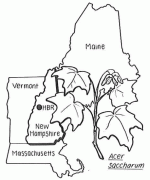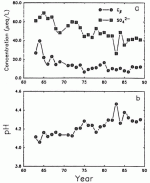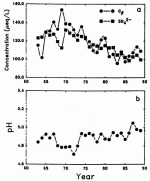The watershed ecosystems of the south-facing slope of the Hubbard Brook Experimental Forest (Watersheds 1 through 6) have been the subject of intensive study for such a long time that it is natural for the uninitiated to wonder what more could be learned there. Through the funding and organizational basis provided by the LTER program at HER, our hope is to continue a carefully crafted combination of ecological monitoring and experimental studies into the distant future, thereby slowly peeling away the mysteries that limit our understanding of ecosystems and their dynamic responses to natural and anthropogenic disturbance.
Hydrochemical Monitoring Studies
The hydrochemical monitoring studies at HER continue to provide both insight into ecosystem dynamics and new, perplexing questions to challenge our current conceptualizations. Take, for example, the long-term behavior of the N input-output budget in the control Watershed 6 (W6). When monitoring began in 1963, the forest on W6 was a rapidly aggrading 50-year-old stand, still recovering from heavy logging early in the century. At that time, stream output of N was low (100 mol/ha/yr) and well below bulk deposition of 200 to 400 mol/ha/yr (Figure 1).
Atmospheric deposition of N continued to increase at HER over the next decade, and stream output showed a coincident rise, actually exceeding bulk precipitation input in 1969. Deposition leveled off at 700 mol/ha/yr after 1973, while stream output dropped precipitously despite the fact that forest biomass increment on the watershed had slowed as the stands matured. From 1982 to 1987 biomass increment was near zero, yet retention of precipitation N continued. Only in the post three years have we begun to see an increase in streamflow losses of N.
The long-term record of atmospheric input and stream output for base cations and sulfate has also revealed an intriguing pattern: declines in regional emissions of SO2 and loading of SO4 and base cations have been reflected in parallel declines of streamwater outputs and, consequently, pH in the stream has remained roughly constant (Figures 2 and 3).
These intriguing results have stimulated our planning for a long-term, chemical manipulation of an undisturbed watershed at HBR. We hope to improve our understanding of the processing of acids and bases and of N by chronically increasing the loading of bases, SO42- and NO3- over a number of years and measuring responses of budgets and key processes at the small plot and landscape level. This manipulation will also provide important data to validate the plant-soil simulation model we have been developing with John Aber (Harvard Forest), VEGIE-MANE.
Other Long-Term Monitoring Efforts
- Studies of the interaction between populations of neotropical migrant songbirds and their principal food source, phytophagous insects
- Gaseous and dry deposition of elements, particularly N and S, as revealed by three complementary methods: air quality monitoring (inferential technique), net throughfall flux, and watershed input-output budgets
- Vegetation dynamics and productivity on control (undisturbed) and treated watersheds
- Heterotrophic processing of detritus and consequent temporal patterns in pool sizes of dead organic matter (forest floor, dead wood and soil organic matter)
Process-Level Studies and Modeling
Process-level studies and modeling in the Ffl3R-LTER are designed to complement the long-term monitoring program. For example, our ability to quantify the internal fluxes of materials in watersheds has been limited by the complexity of water flow pathways in soils. Studies of hillslope hydrology have revealed the magnitude and mechanisms of macropore or pipe flow in HER soils, as well as the existence of ephemeral saturated zones that develop, even in these extremely porous soils after large storm events. Together with information on near-stream water table dynamics, these data are being incorporated into an expanded simulation model of forest hydrology.
An inconsistency in the carbon and nutrient budgets of disturbed watersheds at HER has been linked to overestimates of the magnitude of forest floor dissipation in the first decade of ecosystem recovery, as originally revealed by chronosequence studies. Direct studies of organic matter burial and in situ decay of forest floor have revealed a rate of mineralization that agrees well both with watershed budgets and with predictions from VEGIE-MANE.
The initiation of the LTER project at HBR has stimulated activity in both data management and GIS. A public access electronic bulletin board, "Source of the Brook,” has been implemented allowing easy retrieval of many data sets from the HER ecosystem study. The HBR-GIS supports site management needs and is being increasingly integrated into research activities, including spatial modeling of soil temperature and moisture and trace gas emissions. A major undertaking in the coming months will be to spatially distribute the forest growth simulator, ZELIG, across a gridded landscape. Ultimately, we hope to contribute to an improved understanding of the relationships between spatial scales and vegetation pattern and process in forest simulation models.
For further information contact Timothy Fahey, Cornell University, Department of Natural Resources, Ithaca NY 14853, 607-255-5470.

 Enlarge this image
Enlarge this image




